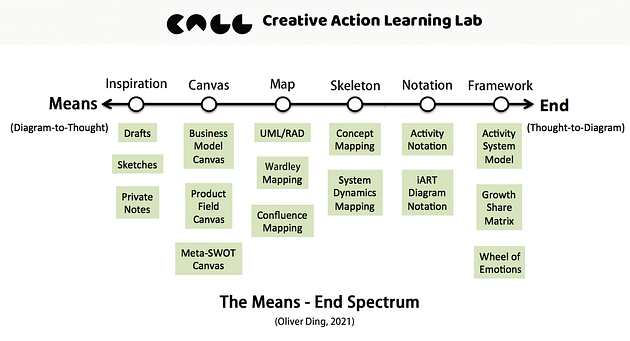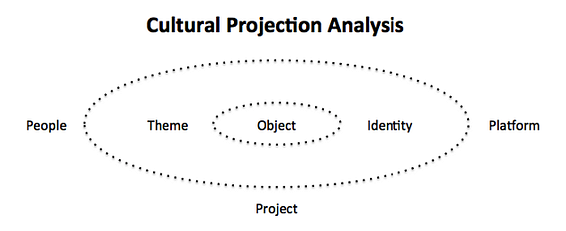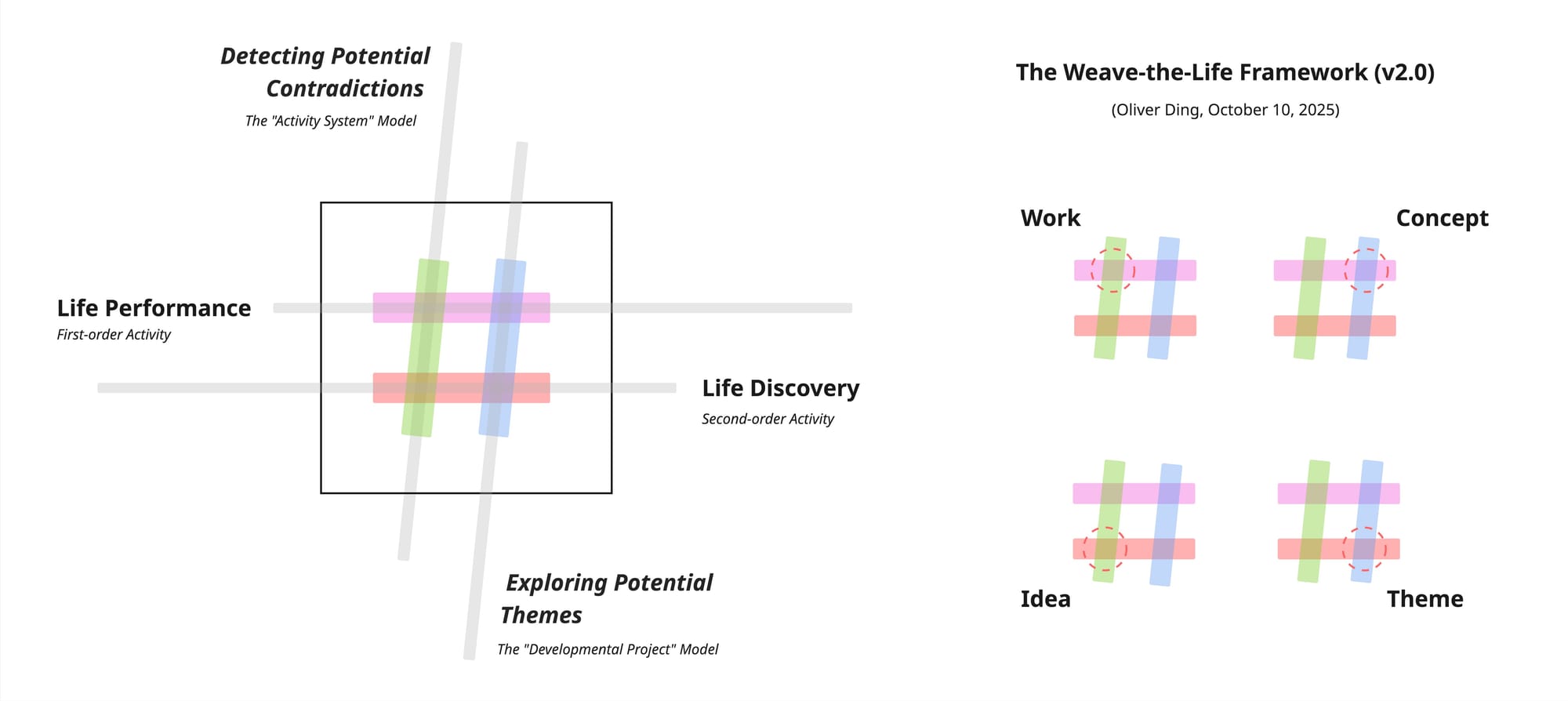Appropriating Activity Theory #3: Means, End, and Creative Chaos

This post is part of the "Appropriating Activity Theory" series, which reflects my creative journey of engaging with Activity Theory from 2015 to 2025.
by Oliver Ding
October 12, 2025
On February 22, 2022, I stayed in a room to conduct a self-dialogue to resolve a creative challenge. The picture shows my workspace that day.

What creative challenge did I face? It resonated with the Means-End principle in Activity Theory. My understanding of the principle extended beyond the immediate situation, leading to a series of insights later.
1
At that time, I was working on an empirical research project about an adult development program run by a friend. I call the program SSL, which stands for Shaper & Supporter Lab — though this is just a codename.
The program was designed with three components:
- 1) Life Purpose Awareness
- 2) Personal OKR Practice
- 3) Peer Review and Feedback
My friend also adopted the Building In Public approach, sharing her goals, challenges, progress, and discussions with others on social media platforms.
Back in August 2021, I started observing the program and developed the initial model of the Anticipatory Activity System (AAS) framework as a research framework to guide my study.

Why did I use “Self, Other, Present, Future” (the iART Framework) as the core of the AAS framework? It aligns with two components of the program:
- Life Purpose Awareness: the “Present — Future” conversation leads to a life strategy.
- Peer Review and Feedback: the “Self — Other” conversation influences a person’s decisions and behavior.
The first-order activity focuses on a person’s performance, guided by their OKRs. The second-order activity refers to the planning and reviewing of these OKRs.
(OKRs: Objectives and Key Results — a concrete framework for goal setting and management.)
The Anticipatory Activity System (AAS) framework is not a concrete framework but an abstract model. It offers a general lens for understanding second-order activity from the perspective of Anticipatory Systems Theory. In other words, it is a hybrid theoretical framework that curates the following two theories:
- Activity Theory
- Anticipatory System Theory
This hybrid approach was inspired by Clay Spinuzzi’s book Network: Theorizing Knowledge Work in Telecommunications. To understand a telecommunications company’s knowledge work, Clay Spinuzzi focuses on the concept of “Network”, adopting two theories to build an abstract framework for theorizing knowledge work:
- Activity Theory
- Actor-Network Theory (ANT)
Can more than two theories be adopted to develop abstract frameworks? I am not sure. It might lead to a brand-new theory, or at least a framework for a case study, or something else.
It might also result in creative chaos, similar to what I faced in February 2022.
At this point, I realized that my challenge was not just theoretical: the program provided a wealth of information and cues, while I was working with multiple frameworks based on different theories. The creative challenge, or “creative chaos,” was to organize, integrate, and make sense of all these materials while maintaining coherence in both research and personal insight.
2
In January 2022, the SSL (Shaper & Supporter Lab) program launched its new version of its developmental service. I realized that I can apply Project-oriented Activity Theory and the Project Engagement toolkit to study its development.
The Project Engagement Toolkit is a project-oriented toolkit designed for theory-based reflection and study. A significant aspect of the toolkit is that it connects two theoretical approaches of Activity Theory and offers a series of tools for practitioners navigating the age of projectification:
- The Activity System Model (Yrjö Engeström, 1987)
- Activity as Formation of Concept (Andy Blunden, 2010, 2012, 2014)

While Engeström’s model is well suited for traditional work projects, Blunden’s approach considers collaborative projects as the foundation of social movements and cultural innovation. By curating these two approaches together, the toolkit offers a cross-boundary solution for balancing individual impact and collective impact. In this way, it provides an innovative method for connecting personal life themes with cultural themes to build a sustainable society collaboratively.
In February 2022, I joined the SSL program’s digital setting, which is based on an enterprise collaboration platform, and began researching the entire program. The founder shared videos of their learning workshops with me on a private channel.
Before that time, I had only observed the program from the outside. Afterward, I moved from the outer space of the project into the inner space. Applying Cultural Projection Analysis, this shift corresponds to Secondary Projecting.

According to Project-oriented Activity Theory, during the Objectification phase, an established project starts attracting participants. Once a project is initiated, it provides Secondary Projectivity for others to recognize potential action opportunities. For this secondary projectivity, its sense-maker is the Identity of the established project.
The diagram above illustrates an abstract model of secondary projecting with two people and one project. Participant A initiates the project, while Participant B recognizes the secondary projectivity and participates.
The core of the spatial logic is the synchronization between formulation of actions and movement of position. Participant B moves from the outside space into the inside space of the project while actualizing the project’s secondary projectivity through real actions.
It is important to note the spatial boundary of the project. Before becoming Participant B, the second person can perceive secondary projectivity only through the sense-maker, i.e., the project’s Identity, because they are not yet inside the project.
Moreover, I applied a method called Multiple-level Project Engagement to study the SSL program. I reflected on the following levels:
- The “My friend — Members” Engagement
- The “Member — Member” Engagement
- The “I — My friend” Engagement
This method constitutes what I call Cultural Projection Analysis within Project-oriented Activity Theory. For more details, see: Activity U (X): Projecting, Projectivity, and Cultural Projection.
This phase of participation also illustrates the challenge: integrating multiple theoretical perspectives while engaging in the project itself created overlapping layers of complexity. My creative chaos was both cognitive (frameworks and theories) and practical (engaging in the project digitally).
3
Finally, I faced a challenge: the SSL program offered such a wealth of information and cues for research, and I was also working on several frameworks based on different theoretical approaches.
How could I handle this creative chaos?
On February 23, 2022, I went to a friend’s office for a monthly checkup. At that time, my friend was overseas for a long trip, and the business activity was low. The house became my one-day personal office. I printed a series of diagrams and conducted a self-dialogue in the room.

The picture above shows a series of diagrams of my knowledge frameworks.
The focus was on the Developmental Project Model, which was the core of the Project Engagement Toolkit (see the picture below).

However, I also wanted to continue developing the Anticipatory Activity System (AAS) framework (see the picture below).

The outcome of the self-dialogue was the diagram shown in the picture below.

This sketch served as my solution for organizing the creative chaos. From the research project, I discovered three key elements:
- Container: An adult developmental program > Developmental Project Model
- Content: The Life Discovery Activity > Anticipatory Activity System
- Context: The Life Discovery Activity > Life as Project > Project Engagement
The Developmental Project Model provides a general framework for understanding a project. In this sense, an adult developmental program can be understood as a Developmental Project in a general sense.
The concrete content of the program was the Life Discovery Activity, which distinguishes this program from other types of projects. However, the Developmental Project Model does not capture individual differences and the unique patterns of individual projects. Therefore, the Anticipatory Activity System framework was needed to discuss the content of the program.
Finally, I realized that both frameworks share the same method: the Project Engagement method. Yet, I was not thinking of this method purely as a research tool, but as a method for life.
Indeed, we should consider the Project Engagement method as a method for life.
The challenge I faced in this self-dialogue was integrating multiple frameworks and abundant information while simultaneously extracting insights that could guide both research and life practice. This creative chaos was ultimately the catalyst for discovering connections between container, content, and context, and for realizing the practical and conceptual value of the frameworks.
Was it a strange loop?
I explore this question in the next section, as the cycle between method, research, and life becomes apparent.
4
The strange loop I experienced reminds me to reflect on the Means — End Spectrum, which I first published on November 29, 2021, to discuss diagramming as practice.
The Means–End issue is a complex topic in Activity Theory and Vygotsky’s Cultural-historical theory of psychology, because scholars interpret Vygotsky’s ideas differently. For example, the mediated action vs mediating activities debate, or Newman and Holzman’s ideas vs Bruner’s formulation. According to Newman and Holzman (1993, p.40),
Vygotsky’s tool-and-result method is purposeful in the Marxian sense, not, contrary to Bruner’s formulation, in the instrumentalist sense. Vygotsky’s rejection of the causal and / or functional methodological notion of tool or instrument for a purpose or result in favor of the dialectical notion of tool-and-result in the study of human psychology is new and revolutionary. (1993, p.40)
From the perspective of Activity Theory, I consider the Means–End issue within concrete activities. For a particular activity, a diagram might be an end — what I call Thought-to-Diagram. For another activity, the same diagram might be a means — Diagram-to-Thought. Combining these two situations produces a Means–End Spectrum, which helps present the various instrumental values of diagrams.

On the spectrum, the left side (Means / Diagram-to-Thought) represents a weak ontological position: diagrams serve as tools for thinking, and we don’t require perfect forms. The right side (End / Thought-to-Diagram) represents a strong ontological position: diagrams are final products for others to use, demanding careful construction.
Based on this spectrum, I identify six types of diagrams — Inspiration, Canvas, Map, Skeleton, Notation, Framework — from the weakest to the strongest ontological position. Inspiration includes drafts, sketches, and private notes, while Framework refers to formal knowledge models.
While this discussion is framed around diagrams, the Means–End Spectrum can be generalized to other domains. Importantly, reflecting on this spectrum was one of the methods I used to organize the creative chaos I encountered in February 2022, connecting theoretical frameworks with practical action.
5
The Means–End Spectrum can also be applied to analyze the Anticipatory Activity System (AAS) at the abstract level, connecting Objective and Object.

In the AAS framework, I focus on the relationship between Object (Object/Objective) and Outcome (Result/Reward). I don’t explicitly place the term “Mediation” on the diagram; instead, I treat Object as the primary concept, with the following operational concepts:
- Raw material
- Mediation/Instrument/Tool
- Resource
- Environment
- Target
The purpose here is not to create a perfect typology of Objects, but to provide a tool for navigating the network of Objects. In real-life activities, each activity involves a set of interacting objects.
Consider the AAS framework as Means: it serves as a tool to understand the SSL program (the Target), while the Life Discovery Project becomes the End from my perspective.
From my friend’s perspective (the founder of SSL):
- Means: the Anticipatory Activity System framework
- Target: the SSL program
- End: design and launch the new version of SSL services
Here we see two Ends from two perspectives. Since I work in the Theory field and my friend in the Practice field, these Ends do not conflict within the same activity. Potential contradictions may arise between Self and Other, which are resolved according to their Self–Other relevance.
Conversely, if we consider the AAS framework as End, then the SSL program functions as a Means for developing the AAS framework. At the concrete level, the configuration is:
- Target: a thesis about the AAS framework
- Raw material: videos, texts, pictures, and other content from SSL
- Mediation/Instrument/Tool: my iMac, my iPhone, and other tools.
- Resource: Support from my friends and members; my thinking and writing skills
- Environment: the digital platform hosting SSL; my physical workspace
What a creative chaos! In theory, we see concepts and perspectives clearly. In real life, however, multiple concepts and perspectives interweave dynamically, creating a complex landscape that demands reflection and careful navigation.
6
Building on the previous reflections on creative chaos and the strange loop, we can also analyze Project Engagement through the Means–End perspective.
If we consider Project Engagement as Means:
- End: Project-oriented Activity Theory
- Target: SSL program
- Means: Cultural Projection Analysis and other methods within Project-oriented Activity Theory (e.g., designing and studying Developmental Service projects using the Developmental Project model)

The core focus of Cultural Projection Analysis is the development of a person’s life themes and identities. From this perspective, Project Engagement serves as a tool to understand the SSL program and support theoretical reflection.
If we consider Project Engagement as End:
- Its development occurs in the Theory field, but it also has value in Practice.
- This creates a new creative space: Project Engagement as a method for life.
In practice, I integrate this approach into the ECHO Way (v2.0) through Life Discovery: the “Present — Future” Fit. The process is roughly designed in three phases:
- Life U: Think with the Theme U diagram.
- Project I: Act with the Developmental Project Model (this is the Project Engagement method in action)
- Echo Z: Reach the end of the journey - an expected place.
Here, Project I represents Project Engagement applied to life, showing how the method can guide action beyond research.

Note that the Developmental Project Model remains an independent framework and can be used without the ECHO Way.
7
The experience was fantastic: it was my embodied experience of applying the Means–End Spectrum in real life, even though the project itself was theoretical.
Later, on October 27, 2022, I revised the Means–End Spectrum, creating a new version called the Diagramming Reference Frame. The major change was the inclusion of two types of diagrams:
- Semiotic System Diagrams: remove spatial structure, retain only conceptual relationships
- Meta-diagrams: remove textual elements, retain only spatial structure

This change was inspired by my study of Hongkong-based theoretical sociologist Ping-keung Lui, whose Semiotic System Diagrams curate sociological theories while embodying langue (abstract theoretical system), in contrast to parole (concrete empirical sociologies). This insight highlighted the need to expand the Spectrum into a matrix, introducing a new dimension in diagrammatic thinking: the Langue–Space dimension.
The Diagramming Reference Frame thus allowed classification not only of diagrams but also of concepts, models, and other knowledge-related entities, defining a Reference Space — a universal tool of thought.

On November 11, 2022, I developed a further diagram, Universal Reference, introducing a new naming convention for dimensions:

Vertical group (Degrees of Abstraction/Knowledge):
- Theory — Practice
- Heaven—Earth
- Langue — Space
- Episteme — Empeiria
Horizontal group (Situations of Activity/Engagement):
- Means-End
- Birth — Death
- Attach — Detach
- Self—Other
This Universal Reference diagram led to two major outcomes: 1) The notion of "World of Activity" and 2) The Knowledge Engagement Framework.
In 2025, the World of Activity approach was born as a hub of my theoretical works.

What began as a small seed — the Means–End Spectrum — had now grown into a large tree of interconnected theoretical frameworks.
8
The day after February 22, 2022, I wrote a long note to record my experience in the room. The note was later published under the title: Life Discovery: The “Means — End” Spectrum and Becoming.
At the end of the article, I wrote:
The Life Discovery Activity focuses on 1) Detecting Potential Contradictions and 2) Exploring Potential Themes in order to enhance a person’s life development.
In order to cope with potential contradictions, we need to adopt objects as Means for solving problems. In order to develop potential themes, we need to adopt objects as End as creative spaces.
The Life Discovery Activity is a continuous flow of becoming.
On the night of October 10, 2025, I revisited the article while reading the words above, and I immediately created a new version of the Weave-the-Life framework (see diagram below).

This diagram curates the Activity System model, the Developmental Project model, and the Anticipatory Activity System (AAS) framework together.
This is an amazing theoretical curation! It also echoes the creative chaos I faced in 2022, when multiple frameworks and methods were in play but existed independently, and my reflections were primarily practice-based.
The newborn Weave-the-Life framework provides an elegant solution, representing the "Weaving" essence of real-life activity. Unlike the fragmented approach in 2022, this theory-based framework curates the three previously discussed theoretical frameworks into a single, coherent structure. In this sense, it serves as a theoretical response to the practice-based reflection I had three years earlier.
What a journey of slow cognition!
v1: October 12, 2025 - 2,841 words
